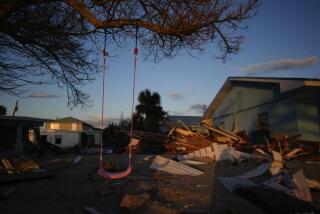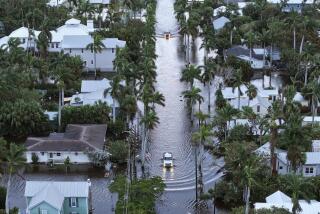Hurricane’s Impact Surprises Florida
MIAMI — Officials in southeast Florida struggled Tuesday to restore power, clear roads and rush water and ice to residents unprepared for the damage inflicted by Hurricane Wilma.
A day after the unexpectedly fierce Category 3 storm blasted in from the west -- killing seven people -- close to 3.1 million Floridians still were without power, said Kristy Campbell, a spokeswoman for the state emergency operations center.
“I don’t think anybody anticipated the damage we woke up to,” Broward County Mayor Kristin Jacobs said. “It’s truly unprecedented.”
Wilma carved a path of destruction across southern Florida’s Atlantic seaboard from Palm Beach County to the Florida Keys. Traffic lights lay smashed on the pavement or dangling precariously from overhead cables. Downed wires, poles and trees obstructed streets.
While some flights resumed Tuesday at Miami International Airport, the region’s two other major airports -- Fort Lauderdale-Hollywood International and Palm Beach International -- remained closed.
In the greater Miami area, 177 of 2,600 traffic lights were working.
“What you have here with this storm is a lot of damage everywhere in the county,” said Miami-Dade Mayor Carlos Alvarez.
Wilma’s winds, which gusted at more than 120 mph, ripped the roof off Erzulie Denis’ three-bedroom North Miami home.
At midday Tuesday, Denis joined about 3,000 people anxiously waiting in a shopping center parking lot for officials to pass out water and ice. She had spent the night in her car with her 14-year-old son, Schiler, who has asthma. Denis was afraid he would have an attack if he slept in their soggy home.
“I don’t know what to do,” said Denis, 34. Neither of her cellphones was working, a common problem in the areas pummeled by Wilma. When she went to her local police department and a hospital to ask for assistance in getting housing, Denis said, she was given more telephone numbers she couldn’t call.
Denis had stocked hurricane supplies, she said, but the bread, potato chips and other foods had gotten waterlogged. “We don’t have anything now,” she said.
Throughout southeastern Florida, where the weather was sunny and pleasant Tuesday, lines began forming as early as 9 a.m. for water and ice. In one spot in Broward County, emergency services spokesman Carl Fowler said, there were at least 2,000 cars. In many cases, the supplies had not arrived by late afternoon.
Deliveries to 15 distribution points in Broward County were delayed when the trucks couldn’t be gassed up because there was no power to run the pumps, said Robert Lincoln, an official with the state Division of Emergency Management.
Broward Mayor Jacobs -- a Democrat -- accused the state government and Republican Gov. Jeb Bush of failing to meet its promises. “We can’t get any answers from the state right now as to when those trucks are expected,” she said.
Water and ice deliveries were also tardy at some of the 11 distribution points opened in Miami-Dade County. “Ladies and gentlemen, we’re trying,” Alvarez told a televised news conference. “We’re really trying.”
During a visit earlier in the day to Miami, Gov. Bush vowed that help was on the way. “My heart goes out to people that have lost a lot, and they can rest assured that the state government and the federal government will be working to provide support.”
President Bush, the governor’s brother -- who plans to travel to Florida on Thursday -- promised swift assistance.
“There are a lot of people without power, and that’s obviously a priority right now,” White House spokesman Scott McClellan said. “We’re working to support the state of Florida’s efforts, and they were well-prepared for this.”
Some Floridians disagreed with that assessment
“To get water, you have to stand five hours in the hot sun. That’s ridiculous,” said Jackie Penha, 30, a bank employee who was among those waiting in the parking lot of a North Miami Beach shopping center.
Esther Feinerman, a Miami Beach real estate agent, had come with a little cart to haul water and ice home, but fumed that police and National Guard members couldn’t tell her when supplies would arrive.
“Florida is a Third World country operating in the U.S.,” said Feinerman, who gave her age as “over 50.” She had used a spaghetti pot to scoop water from her apartment building’s swimming pool to fill up her toilet tank so that she could flush it, she said.
Like many in South Florida, Feinerman said, she had underestimated Wilma. “Where we missed is thinking it would be a Category 1, maybe 2,” she said. “That’s why I only got one pair of batteries for the radio.”
The Pastors, retirees from New York who spend winters in Sunny Isles Beach, also weren’t expecting a major hurricane to strike from the west.
“We knew it was coming, but we didn’t expect it to be this devastating,” said Joseph Pastor, 78, a retired bandleader and schoolteacher. His wife, Theda Pastor, said that as a consequence, they hadn’t stocked up on water.
In Broward County, Fowler said the promised deliveries of water and ice began arriving in late afternoon, although all distribution points might not receive them by the end of the day. People who had been waiting in line would be allowed to violate the 7 p.m.-to-7 a.m. countywide curfew so they could receive their supplies, he said.
One private company, Risk Management Solutions, estimated that Wilma -- the seventh hurricane to make landfall in Florida in 15 months -- may have caused $6 billion to $10 billion in property damage. Campbell, the state emergency services spokeswoman, said there was no official estimate.
“It’s too soon to tell,” she said from Tallahassee. “Right now, the focus is on safety issues.”
More to Read
Sign up for Essential California
The most important California stories and recommendations in your inbox every morning.
You may occasionally receive promotional content from the Los Angeles Times.










